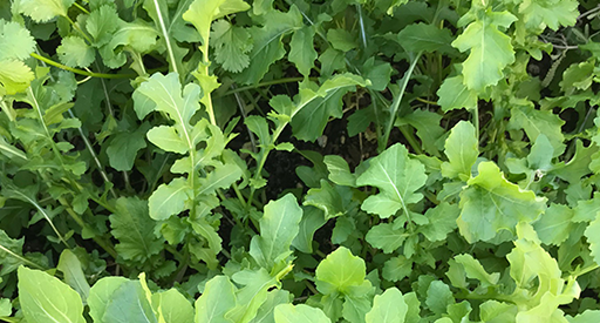
Rocket Quick Start Checklist
- Choose a sunny spot for vibrant, peppery leaves.
- Prepare the soil well with organic matter like Tui Compost and Tui Organic Sheep Pellets. Blend in a layer of vege friendly potting mix like Tui Vegetable Mix before planting.
- Feed regularly in spring and summer using a nitrogren-rich fertiliser option that best suits you. For quick visible results try Tui Vege & Herb Liquid Superfood.
- Mulch and protect: keep roots cool and moist with Tui Mulch & Feed and protect from slugs with Tui Quash for a healthy, lasting harvest.
- Water consistently and harvest regularly to encourage continuous fresh growth.
Why choose Rocket?
Rocket (also known as arugula) is a fast-growing leafy green, popular in salads and egg or cheese dishes, known for its bold, peppery flavour. It’s beginner-friendly, ideal for pots or garden beds and available in both annual (one season) and perennial (multiple season) varieties.
For first-time gardeners, seedlings are convenient while seeds offer a cost-effective option. Whether you choose seedlings for ease or seeds for affordability, follow planting instructions on each packet or label.
Refer to the Tui Planting Calendar for when to plant in your region.
Prepare the Soil
- Rocket thrives in full sun to part shade. It prefers cooler temperatures so is suitable for planting in spring and autumn in most climates. In warmer climates, providing some shade during the hottest part of the day can be beneficial.
- Rocket loves rich, free-draining base so try mixing Tui Compost and Tui Organic Sheep Pellets into your garden bed to give the soil structure and replace nutrients.
Get Planting
Growing from seed
- Seeds can be sown direct or into trays.
- Before planting work Tui Seed Raising Mix into soil, or use mix to prepare seed trays.
- Sow seeds 10mm deep and if planting direct space 5cm apart, or closer together if you want small salad leaves.
- Keep well-watered.
- Seedlings can be transplanted once they have two seeds of true leaves.
- Keep sowing directly every two weeks for a continuous supply.
Planting seedlings
- It’s best to plant in the early morning or late afternoon, when the sun isn’t too intense, to avoid wilting.
- To reduce transplant shock, soak the seedlings in Tui Organic Seaweed Plant Tonic and allow to drain.
- Select your planting spot and space seedlings according the seed packet or seedling label. You can plant more densely if you prefer to harvest small salad leaves.
- If you’re planting in the garden add a layer of Tui Vegetable Mix; developed to give vege crops a strong start and includes a blend of fertilisers, sheep pellets, blood & bone and dolomite lime to support initial plant growth
- If you’re planting in pots and containers, fill with Tui Vegetable Mix.
- Dig a hole slightly bigger than the root ball, then place seedlings into the planting hole and fill around it.
- Water well and maintain regular watering.
Feed and Nourish
- Feed your plants and they will feed you. Rocket is a crop that relies on being fed continuously.
- Choose from a variety of different Tui fertiliser options, depending on what suits you and your garden:
- Tui Vege & Herb Liquid Superfood is perfect for quick results as plants are able to absorb the nutrients immediately. Apply weekly in the growing season. Suitable for use in the garden or pots and containers.
- Tui Vegetable Food is a granular option formulated specifically for veges planted in garden beds. It can be applied every four weeks and is not recommended for pots and containers.
- Enrich Vege, Tomato & Herb Controlled Release Fertiliser lasts up to six months, making it perfect for gardeners who prefer a ‘feed and forget’ option. It’s also suitable for pots and containers.
- Tui Performance Organics Tomato & Vegetable Fertiliser pellets are an organic option that can be used both in the garden and in pots and containers.
- Keep soil free of weeds and protect roots with Tui Mulch & Feed.
- Protect from slugs and snails by applying Tui Quash every few weeks.
Frequently Asked Questions
When is the best time to plant rocket?
- Rocket prefers cooler temperatures so prefers planting in spring and autumn in most climates, however it can generally be grown year round in New Zealand. In warmer climates, providing some shade during the hottest part of the day can be beneficial.
- For a steady supply of fresh leaves, direct sow seeds every two weeks.
How long does rocket take to grow and be ready for harvest?
- Rocket is a fast-growing leafy green that’s ready to harvest 4–6 weeks after planting seedlings, depending on the weather and how well it’s cared for.
- Regular watering and picking encourage fresh new growth.
How can I stop my rocket from bolting?
- Rocket often bolts (flowers and goes to seed) in hot or dry conditions, or when there is a sudden change in temperature. Once it bolts, the leaves can become bitter. To reduce bolting:
- Keep soil evenly moist.
- Provide light shade during the hottest part of the day.
- Harvest leaves regularly to encourage continued growth.
Discover more advice and inspiration for growing your own veges at the Vege Hub >